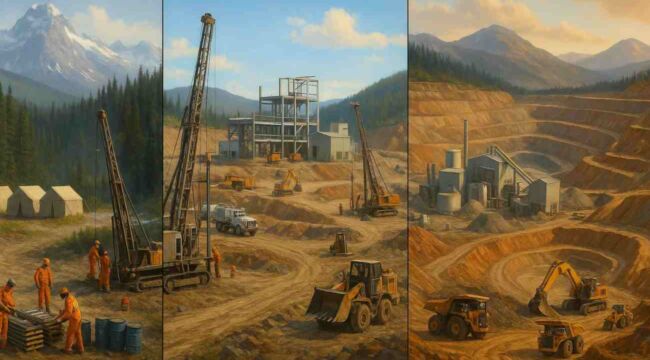The 3 Stages of Gold Miners
As we wait patiently for this correction in gold, silver, and miners to end, now is an excellent time to review the fundamentals of precious metal miners.
This is especially important for those of you looking to start or add to positions during this pullback.
Today we’re going to explore the three types of mining stocks:
- Producers
- Developers
- Explorers.
We’ll explain the risk/reward of each stage, which is critical to finding success in this sector.
Producers: The Safest Bet
Producers are miners already producing metal. Barrick Mining (B) is a classic example of a large (senior) gold producer.
In 2024, Barrick produced 3.91 million ounces of gold, worth over $15 billion at $4,000/oz. The company also produced 195,000 tonnes of copper, and plenty of silver, lead, and other metals.
Producers are the safest bet in mining, yet still offer plenty of upside. They tend to outperform in the early stages of precious metal bull markets.
Because they’re already producing metal, rising gold and silver prices immediately boost their revenue and profitability.
Well-run producers have significant leverage to underlying precious metal prices.
For example, let’s say that 2 years ago, the average producer was pulling gold from the ground at a cost of $1,300 per ounce and selling it at $1,900.
That’s a profit of $600/oz, not bad. But today many producers are pulling gold out of the dirt for $1,500/oz, and selling it at $4,000.
That’s a profit of $2,500 per ounce. About 4x higher than it was just 2 years ago. This is why it’s not surprising that big gold miners have nearly doubled over the last year. And why they could have much further to run.
Institutional investors tend to stick to producers, because only these companies have the liquidity and size that allow substantial buying.
Producers are great. The vast majority of my portfolio is in this stage.
But some people like a higher risk/reward, and that’s where developers (and explorers) come into play.
Developers: Harder Difficulty
Gold/silver developers are companies that have already gotten through the exploration stage. They’ve drilled and surveyed their claims, and now it’s time to start getting all the necessary permits and building infrastructure.
Developers have little, if any revenue. Yet they do have substantial costs. So raising money is an important part of being a development-stage miner. You need an experienced team who knows how to navigate capital markets.
A great management team will minimize share dilution and raise capital strategically and smartly. Most others will dilute heavily and struggle to reward shareholders.
Investing in developers isn’t easy. You need to correctly analyze:
- Geology – is the deposit a worthy one?
- Capital markets – is the company efficiently raising money?
- Management – does leadership know how to hire the right team and run a mine?
Investing in developers is far more challenging than producers. But it can be extremely rewarding. Successfully investing in developers also takes patience. It takes many years to successfully develop a precious metals mine.
Development-stage miners sometimes outperform producers in the second stage of a bull market (we have only begun to see hints of this).
But unless you’re a geologist with deep investing experience, it’s best to leave this category to the experts like Jim Rickards, Byron King, and Dan Amoss.
And still, I prefer to keep the vast majority of my miner exposure in producers.
Explorers: Advanced Investors Only
Ahh, now we finally come to the explorers. This includes the “penny dreadfuls”, as Rick Rule calls them. The tiny juniors with nothing but a patch of dirt, a dream, and an investor pitch deck.
In previous bull markets, explorers have outperformed in the later stages of the cycle. Once general investors flood into the market, they often seek out high leverage opportunities. And when money floods into this miniscule corner of the market, things can get crazy.
It’s important to note, however, that the vast majority of explorer-stage miners will fail. Their deposit won’t pan out, or they’ll fail to raise the necessary capital. Or they won’t get the necessary permits. Or one of a dozen other bad outcomes will happen.
However, maybe 1% of explorers will eventually become huge winners (100x+ returns are possible over many years). These are the few that will make it to the large-scale production stage, or become acquired somewhere along the way.
But picking winning explorers isn’t easy, even for professionals. This stage is for advanced investors only. If you’re buying explorers based on some random article or post you find online, chances are high you’re being marketed to.
The mining space is full of stock promotions, so whenever you hear a pitch for a tiny junior explorer, your spidey-senses should be tingling.
Don’t get me wrong, in a bull market you can make money even on mediocre explorers. But just keep in mind that there’s a good chance the company won’t make it to the development or producer stages.
Only invest in explorers when recommended by someone you trust. And even then, there’s a decent chance it won’t work out.
If you want to also speculate on some explorers and developers, do so thoughtfully. Follow the lead of experts like the ones we have here at Paradigm. Jim Rickards, Dan Amoss, and Byron King are all world-class mining analysts. And even then, they’ll mostly steer you towards the big producers, because they offer a superior risk/reward equation.
For a diversified approach to smaller stocks in this sector, I like the Sprott Junior Gold Miner ETF (SGDJ). There’s also the GDXJ “junior” miner ETF, but that’s really not a junior fund. It’s become too large, and so they’ve been forced to invest in stocks that aren’t exactly junior.
For most investors, sticking to senior producers is by far the safest bet. And as I mentioned, there’s still plenty of upside in these stocks.
One final note. There is overlap within these stages. For example, producers are also exploring and developing. But explorers are not producing. And that’s a key difference.



Comments: